Adani Power Limited Bundle
Can Adani Power Continue to Illuminate India's Energy Future?
Adani Power Limited, a titan in India's energy sector, has consistently demonstrated the importance of a robust Adani Power Limited SWOT Analysis as part of its growth strategy. Founded in 1996, the company rapidly evolved into India's largest private thermal power producer, showcasing its ambitious expansion with the commissioning of its first 660 MW unit in 2009. This exploration dives into Adani Power's strategic initiatives and future prospects, examining how it plans to navigate the dynamic Indian energy sector.
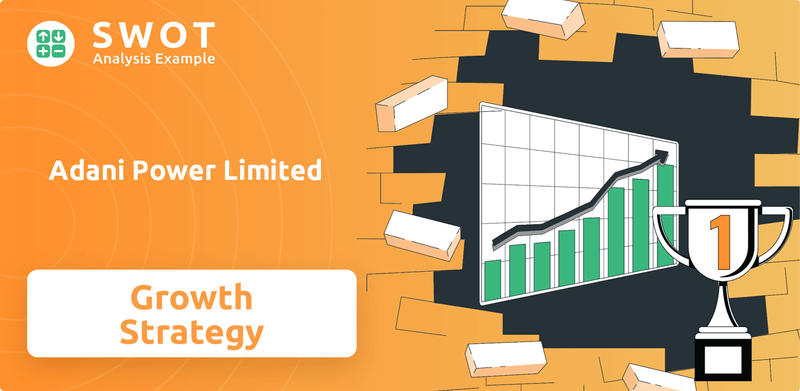
The Indian power generation landscape, driven by economic growth and urbanization, presents both significant investment opportunities and challenges for Adani Power. Its ability to adapt to policy changes, technological advancements, and market demands will be key to its continued success and revenue growth analysis. This analysis will explore Adani Power's expansion plans 2024, focusing on its strategic initiatives, financial performance, and competitive landscape within the energy sector.
How Is Adani Power Limited Expanding Its Reach?
Adani Power is actively pursuing several expansion initiatives to strengthen its market position and diversify its energy portfolio. The company's Growth Strategy involves a dual approach: increasing its thermal Power Generation capacity and exploring opportunities in renewable energy sources. This strategic move aims to meet the escalating power demand in India and adapt to evolving energy policies.
A significant aspect of Adani Power's expansion includes commissioning new units and acquiring operational power plants. The Godda Ultra-supercritical Thermal Power Project in Jharkhand, with a capacity of 1600 MW, is a prime example of this strategy. This project is designed to supply power to Bangladesh, signifying a strategic move into cross-border power trade.
Furthermore, Adani Power is focusing on enhancing its presence in the renewable energy sector. While primarily a thermal power producer, the broader Adani Group has ambitious renewable energy targets, which Adani Power may leverage for future growth. The company also concentrates on improving the efficiency of its existing plants through technological upgrades and operational enhancements.
Adani Power is increasing its thermal power capacity through new projects and acquisitions. The Godda project is a key example, designed to supply power to Bangladesh. This expansion is crucial for meeting growing energy demands and diversifying revenue streams.
The company is exploring opportunities in the renewable energy sector. This aligns with the broader industry shift towards sustainable power generation. The Adani Group's aggressive renewable energy targets provide a framework for Adani Power's future growth in this area.
Adani Power focuses on improving the efficiency and output of its existing plants. This includes technological upgrades and operational enhancements. These initiatives are aimed at maximizing the performance of current assets and reducing operational costs.
The company uses mergers and acquisitions to expand its capacity. The acquisition of DB Power Limited, which added 1,200 MW of thermal power capacity, is a good example. This strategy helps accelerate growth and increase market share.
These initiatives are designed to meet India's increasing power demand and adapt to changing energy policies. The company's approach includes both organic growth through new projects and inorganic growth through acquisitions. The company's strategic approach includes a mix of organic growth through new projects and inorganic growth through mergers and acquisitions. For more details on the company's target market, you can read about it in Target Market of Adani Power Limited.
Adani Power's expansion strategy includes increasing thermal power capacity and entering the renewable energy sector. The company focuses on both organic and inorganic growth. This approach helps in meeting the rising power demand and adapting to industry changes.
- Commissioning new thermal power units, such as the Godda project.
- Exploring renewable energy projects to diversify the energy mix.
- Improving the efficiency of existing power plants.
- Strategic acquisitions to increase capacity and market presence.
Adani Power Limited SWOT Analysis
- Complete SWOT Breakdown
- Fully Customizable
- Editable in Excel & Word
- Professional Formatting
- Investor-Ready Format
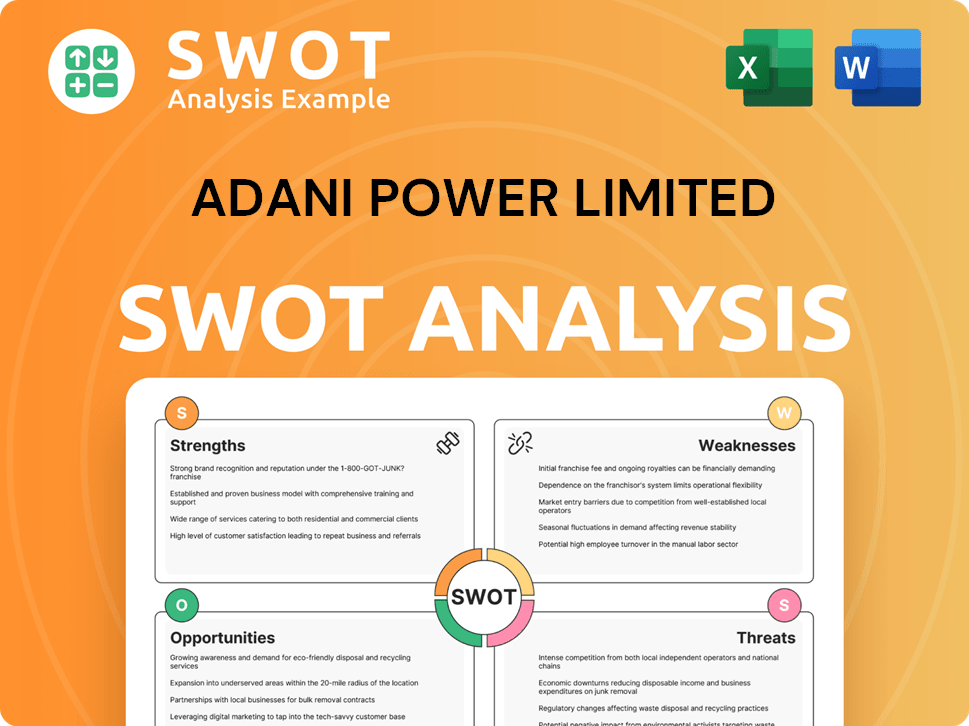
How Does Adani Power Limited Invest in Innovation?
The innovation and technology strategy of Adani Power is central to its sustained growth within the power generation sector. The company strategically employs technology to enhance the efficiency and environmental profile of its thermal power plants. This approach is critical for maintaining its competitive edge and meeting evolving energy demands.
Adani Power focuses on integrating advanced technologies to optimize fuel consumption, reduce emissions, and improve operational reliability. This commitment is evident in the adoption of supercritical and ultra-supercritical technologies in its newer plants, which significantly boost efficiency and lower the environmental impact compared to older facilities. This focus on technological upgrades supports its growth objectives by ensuring reliable and cost-effective power generation.
The company's digital transformation initiatives involve implementing digital solutions for plant monitoring, predictive maintenance, and supply chain management. These measures aim to improve operational efficiency and reduce downtime. While specific details on these initiatives are not always extensively publicized, the focus on operational technology (OT) is crucial for its core business. Moreover, the broader Adani Group's investments in renewable energy and green hydrogen could indirectly influence Adani Power's long-term technology strategy as the energy landscape changes.
Adani Power invests in supercritical and ultra-supercritical technologies to enhance plant efficiency. These technologies are designed to reduce coal consumption and lower CO2 emissions. The Godda Ultra-supercritical Thermal Power Project is a prime example of this technology adoption.
The company implements digital solutions for plant monitoring, predictive maintenance, and supply chain management. This digital transformation aims to improve operational efficiency and reduce downtime. The focus is on operational technology (OT) to streamline processes.
Adani Power aligns with the broader Adani Group's sustainability goals by investing in renewable energy and green hydrogen. These initiatives indirectly influence Adani Power's long-term technology strategy. The company continuously seeks to integrate best practices to meet environmental norms.
Adani Power focuses on integrating best practices in engineering and operations. This ensures optimal performance and adherence to environmental norms. The goal is to ensure reliable and cost-effective power generation.
Investments in advanced technologies are a key part of Adani Power's strategy. These investments aim to enhance efficiency, reduce emissions, and improve overall operational reliability. The company's approach supports its long-term growth objectives.
The adoption of supercritical and ultra-supercritical technologies leads to significant efficiency improvements. This technology helps in reducing coal consumption and minimizing environmental impact. The Godda project exemplifies this commitment.
Adani Power's technology strategy is multifaceted, focusing on efficiency, digital transformation, and sustainability. These elements are crucial for its future prospects and growth. The company's approach supports its long-term goals in the energy sector.
- Supercritical and Ultra-supercritical Technology: Enhances efficiency and reduces emissions.
- Digital Solutions: Improves operational efficiency through plant monitoring and predictive maintenance.
- Sustainability Initiatives: Aligns with the broader Adani Group's renewable energy and green hydrogen projects.
- Operational Excellence: Integrates best practices to ensure optimal performance.
For more insights into the company's background, consider reading Brief History of Adani Power Limited.
Adani Power Limited PESTLE Analysis
- Covers All 6 PESTLE Categories
- No Research Needed – Save Hours of Work
- Built by Experts, Trusted by Consultants
- Instant Download, Ready to Use
- 100% Editable, Fully Customizable
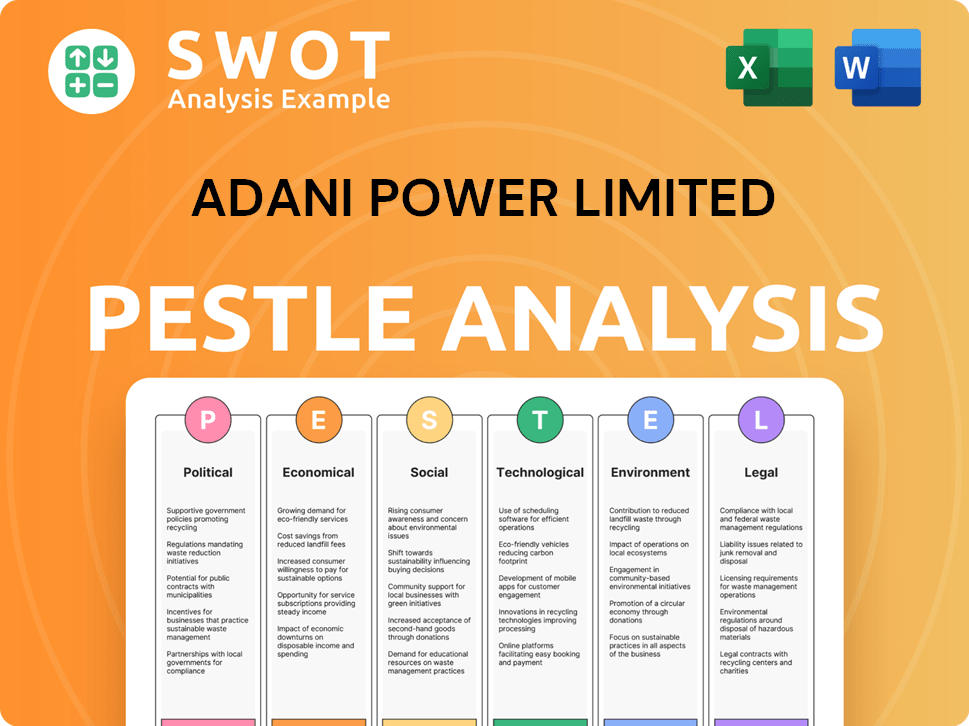
What Is Adani Power Limited’s Growth Forecast?
The financial outlook for Adani Power is robust, supported by strong performance and strategic initiatives. In the fiscal year ending March 31, 2024, the company reported a significant increase in consolidated net profit, reaching ₹2,737 crore, compared to ₹1,069 crore in the previous fiscal year. This growth reflects Adani Power's ability to capitalize on the increasing power demand in India.
The company's consolidated total income for Q4 FY24 also rose to ₹13,363.69 crore from ₹10,795.34 crore in Q4 FY23. This financial performance underscores the effectiveness of Adani Power's growth strategy and its ability to maintain a strong position in the energy sector. These financial achievements are crucial for its future expansion plans.
Adani Power's strategic focus includes optimizing operational efficiency, securing long-term power purchase agreements, and expanding its generation capacity. These actions are expected to contribute to sustained financial health. Analyst forecasts generally anticipate continued stable performance, given the essential nature of its services and the rising power consumption in India. The company's commitment to reducing debt and improving financial leverage further strengthens its positive financial outlook.
Adani Power's revenue growth is driven by increased power demand and improved plant availability. The company's ability to efficiently manage its operations and secure long-term contracts contributes to its revenue stability. This growth is a key indicator of the company's success in the energy sector.
The substantial increase in net profit to ₹2,737 crore in FY24 demonstrates Adani Power's improved profitability. This increase is a direct result of higher revenues and efficient cost management. The company's focus on operational excellence enhances its profitability.
Adani Power's strategic initiatives include securing power purchase agreements and expanding its generation capacity. These initiatives support the company's long-term growth targets. The company's strategic investments are crucial for its future prospects.
The company's efforts to reduce debt and improve its financial leverage contribute to a positive financial outlook. Effective debt management provides a strong foundation for future investments. This focus on financial stability is critical for sustained growth.
Adani Power's strong financial performance positions it well to fund strategic initiatives. The company's essential services and increasing power consumption in India support its market position. This strong market position is a key driver for its future growth.
The financial narrative indicates a healthy trajectory, positioning Adani Power to achieve its long-term growth targets. Adani Power's consistent efforts to reduce its debt and improve its financial leverage also contribute to a positive financial outlook. The company is well-placed to capitalize on future opportunities.
Adani Power Limited Business Model Canvas
- Complete 9-Block Business Model Canvas
- Effortlessly Communicate Your Business Strategy
- Investor-Ready BMC Format
- 100% Editable and Customizable
- Clear and Structured Layout
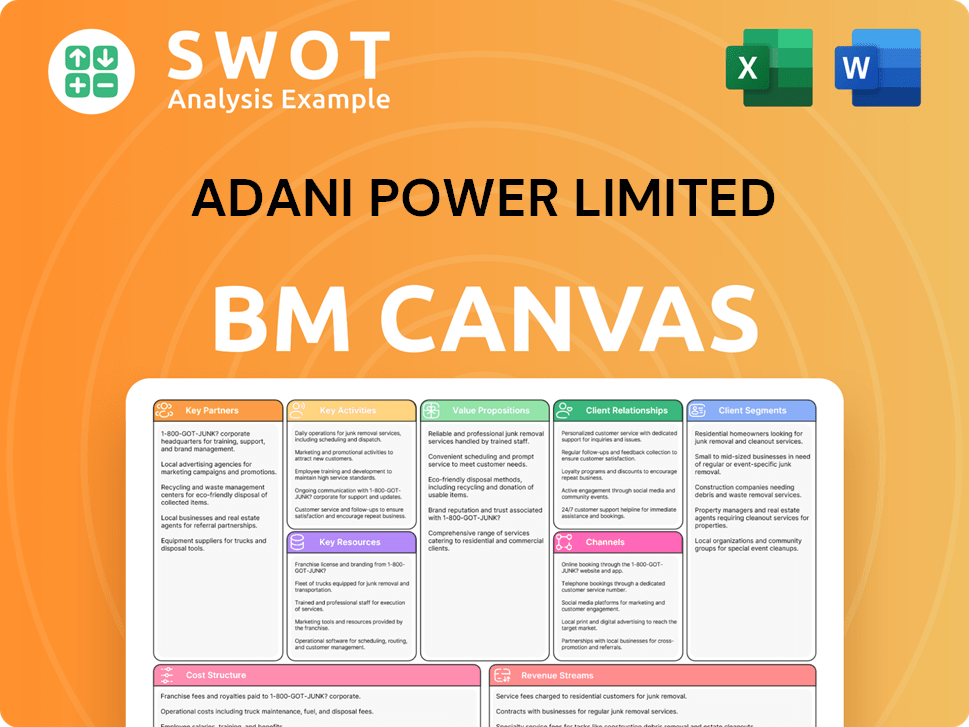
What Risks Could Slow Adani Power Limited’s Growth?
The Growth Strategy and Future Prospects of Adani Power are subject to several risks. The company must navigate a competitive market, regulatory changes, and supply chain vulnerabilities to achieve its expansion goals. These challenges could impact financial performance and require proactive management strategies.
Adani Power faces risks related to market competition from both private and state-owned entities in the Power Generation sector. Changes in regulations, particularly concerning environmental norms and tariff structures, pose a continuous threat. Additionally, the company's reliance on coal introduces supply chain risks, including price fluctuations and logistical issues, affecting operational costs.
Technological advancements, especially in renewable energy, present both opportunities and risks. Internal resource constraints, such as skilled labor and capital, could hinder large-scale project development. Addressing these risks requires a diversified approach, including fuel source diversification, robust risk management, and proactive engagement with regulatory bodies.
The Energy Sector in India is highly competitive, with numerous private and public players vying for market share. This competition necessitates continuous cost optimization and securing favorable Power Purchase Agreements (PPAs). Adani Power must differentiate itself through efficiency and strategic partnerships to maintain a competitive edge. The competitive landscape directly impacts Adani Power’s ability to secure new projects and maintain profitability.
Changes in government policies, including environmental regulations, fuel allocation, and tariff structures, pose significant risks. Stricter emission standards and shifts in coal pricing can increase operational costs. The company must stay compliant with evolving regulations to avoid penalties and maintain operational continuity. These regulatory changes directly affect Adani Power’s financial performance and long-term planning.
Reliance on coal as a primary fuel source exposes Adani Power to supply chain vulnerabilities. Fluctuations in coal prices and logistical challenges can directly impact input costs. While the company has captive coal mines and long-term supply agreements, these do not eliminate the risks entirely. Managing the supply chain effectively is crucial for maintaining profitability and operational stability.
The rapid advancement of renewable energy technologies presents a potential risk. Failure to adapt to the shift towards renewables could impact the company's market position. Adani Power must invest in new technologies and diversify its energy portfolio to remain competitive. This strategic adaptation is crucial for long-term sustainability and growth. For more insights, you can explore the Marketing Strategy of Adani Power Limited.
Internal resource constraints, such as skilled manpower and capital, can slow down expansion plans. Securing adequate funding and attracting qualified personnel are critical for project execution. Managing these constraints effectively is essential for achieving the company's growth objectives. Efficient resource allocation directly impacts the pace of Adani Power’s expansion initiatives.
Increasing pressure for decarbonization and the transition to a cleaner energy economy necessitate significant investments. Adani Power must strategically shift its energy portfolio towards cleaner sources. This transition requires substantial capital and strategic planning to ensure long-term sustainability. Adapting to decarbonization is crucial for the company's future growth and environmental compliance.
Adani Power mitigates risks through diversification of fuel sources and robust risk management. The Godda project, tied to an international power purchase agreement, diversifies the customer base. Optimizing fuel mix and improving operational efficiencies have historically helped navigate challenges. These strategic initiatives are crucial for maintaining financial stability and operational resilience.
The risks outlined can significantly affect Adani Power’s financial performance. Fluctuations in coal prices, regulatory changes, and technological disruptions can impact revenue and profitability. The company's ability to manage these risks will determine its financial success. Proactive risk management is essential for protecting Investment and ensuring sustainable Growth Strategy.
Adani Power Limited Porter's Five Forces Analysis
- Covers All 5 Competitive Forces in Detail
- Structured for Consultants, Students, and Founders
- 100% Editable in Microsoft Word & Excel
- Instant Digital Download – Use Immediately
- Compatible with Mac & PC – Fully Unlocked
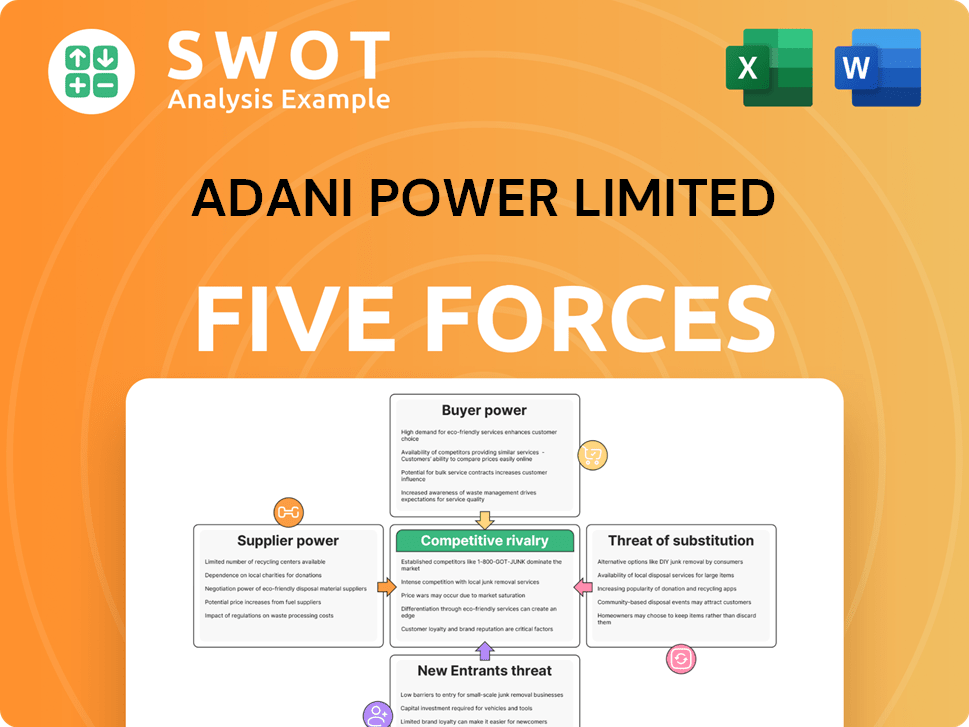
Related Blogs
- What are Mission Vision & Core Values of Adani Power Limited Company?
- What is Competitive Landscape of Adani Power Limited Company?
- How Does Adani Power Limited Company Work?
- What is Sales and Marketing Strategy of Adani Power Limited Company?
- What is Brief History of Adani Power Limited Company?
- Who Owns Adani Power Limited Company?
- What is Customer Demographics and Target Market of Adani Power Limited Company?
Disclaimer
All information, articles, and product details provided on this website are for general informational and educational purposes only. We do not claim any ownership over, nor do we intend to infringe upon, any trademarks, copyrights, logos, brand names, or other intellectual property mentioned or depicted on this site. Such intellectual property remains the property of its respective owners, and any references here are made solely for identification or informational purposes, without implying any affiliation, endorsement, or partnership.
We make no representations or warranties, express or implied, regarding the accuracy, completeness, or suitability of any content or products presented. Nothing on this website should be construed as legal, tax, investment, financial, medical, or other professional advice. In addition, no part of this site—including articles or product references—constitutes a solicitation, recommendation, endorsement, advertisement, or offer to buy or sell any securities, franchises, or other financial instruments, particularly in jurisdictions where such activity would be unlawful.
All content is of a general nature and may not address the specific circumstances of any individual or entity. It is not a substitute for professional advice or services. Any actions you take based on the information provided here are strictly at your own risk. You accept full responsibility for any decisions or outcomes arising from your use of this website and agree to release us from any liability in connection with your use of, or reliance upon, the content or products found herein.